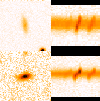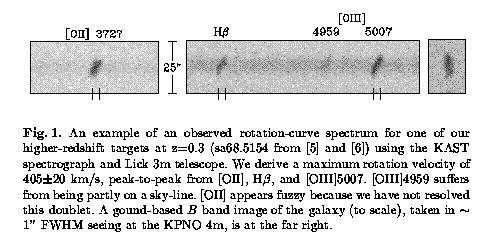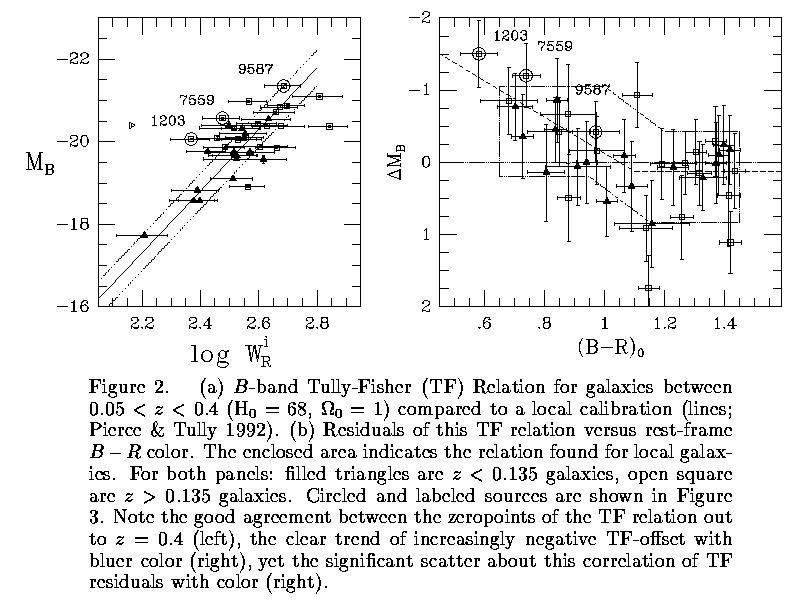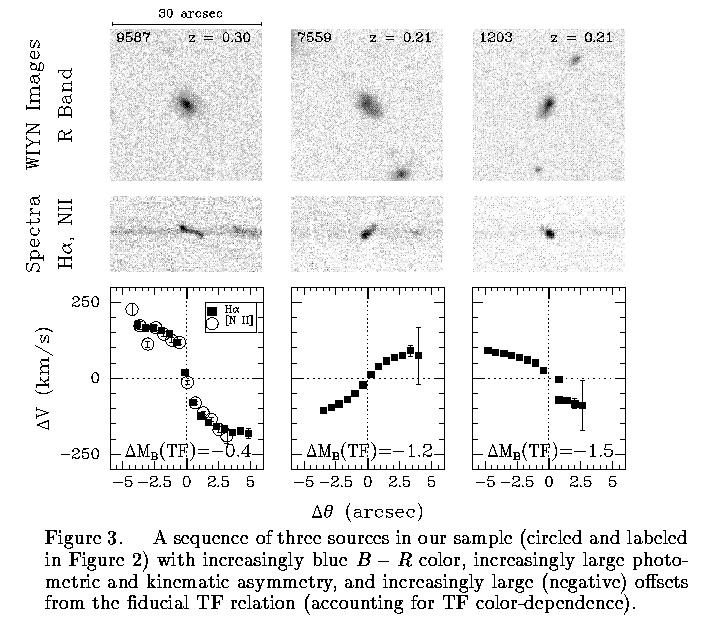 Kinematics of Distant Galaxies
Kinematics of Distant Galaxies  Kinematics of Distant Galaxies
Kinematics of Distant Galaxies Collaborators: C. Mihos, D. Koo, M. Haynes, R. Giovanelli
A kinematic and photometric survey of roughly 50 luminous disk galaxies between redshifts of 0.05 and 0.4 of the Sun) is being conducted to determine if the mass-to-light ratio (M/L)for such systems evolves at a look-back time equivalent to the age of the Sun.
Optical rotation curves in H-alpha have been obtained at the Lick 3m and Palomar 5m telescopes, and high resolution R and I band images have been gathered at the WIYN 3.5m telescope. Near-infrared K-band images exist for a sub-set of the sample. These data will allow us to measure the correlation between the rotation speed and the luminosity of these systems, i.e., the Tully-Fisher relation. Optical colors and high resolution images will also allow us to assess possible causes for unusual M/L, and to determine if the sizes of disks remain constant at a given luminosity and rotation speed.

There was a time, not too long ago, when astronomers believed it was impossible to measure rotation curves for distant galaxies on 4m-class telescope. So impossible was it believed to be, no telescope allocation committee would grant you time to try. The obvious solution was to do it on a 3m telescope when nobody was looking.
(b) No Tully-Fisher Evolution: The current results from our survey indicate that the mean relationship between rotation speed and luminosity remains constant over the past 5 Gyr for luminous spiral galaxies. In addition, we find that residuals from the B-band Tully-Fisher relationship are strongly correlated with color, but that this correlation also remains unchanged with redshift. These results have been presented in Bershady & Andersen (2001), Bershady & Andersen (1999), and Bershady, Haynes, Giovanelli & Andersen (1999). The implications are that large disks were well in place at the epoch when the Sun formed; the time when large disks formed must be substantially earlier in time.
In the followin figure, residuals from the intermediate-redshift Tully-Fisher relation (z = 0.05 to 0.4) show an offset with color the completely accounts for the apparent trend with redshift (from Bershady and Andersen 2001). The three labeled sources are zdiscussed next.

(c) Signatures of building galaxy disks? We do find a plausible hint that some of the scatter in the Tully-Fisher relationship is caused by optically lopsided galaxies -- particularly those systems where the optical lopsidedness is also accompanied by kinematic lopsidedness. This may be an indication that these systems have been substantially perturbed, possibly due to accretion of a small satellite. Future surveys should be able to quantify the statistical occurence (in a comoving sense) of such events. A change in the relative number of these lopsided systems would be a clear signature of an increase in the merger and accretion rate in the past, as predicited by CDM structure formtion history, and conjectured on the basis of the peculiar image structure of distant galaxies.

Publications:
The Evolution of Spiral Disks, M. A. Bershady and D. R. Andersen 1999, to appear in "Dynamics of Galaxies: from the Early Universe to the Present," eds. F. Combes, G.A. Mamon & V. Charmandaris (San Francisco: ASP), 197, 175. (reprint: [astro-ph/9910281]) Funded under AST-9970780
Rotation Curves and M/L Evolution for Galaxies to z=0.4, Bershady, M. A., Haynes, M. P., Giovanelli, R., Andersen, D. R. 1999, in "Galaxy Dynamics," eds. D.R. Merritt, M. Valluri, J.A. Sellwood (ASP Conference Series), 182, 499 (reprint: [UW Preprint])
Mass Estimates of Starbursting Galaxies: Line Widths versus Near-IR Luminosities, Jangren, A., Bershady, M. A., & Gronwall, C. 199, in "Galaxy Dynamics," eds. D.R. Merritt, M. Valluri, J.A. Sellwood (ASP Conference Series), 182, 503 (reprint: [UW Preprint])
Galaxy Kinematics with Integral Field Spectroscopy, Andersen, D. R., Bershady, M. A. 1999, in "Galaxy Dynamics," eds. D.R. Merritt, M. Valluri, J.A. Sellwood (ASP Conference Series), 182, 215 (reprint: [UW Preprint]) Funded under AST-9618849
Galaxy Kinematics with Integral Field Spectroscopy and the Hobby-Eberly Telescope, Bershady, M. A., Andersen, D., Ramsey, L., Horner, S. 1998, Fiber Optics in Astronomy III, eds. S. Arribas, E. Mediavilla, F. Watson, (ASP Conference Series), 152, 253 (reprint: [high resolution]) Funded under AST-9618849
Spatially Resolved Kinematics of Distant Galaxies, Bershady, M.A. 1997, to appear in "Dark and Visible Matter in Galaxies and Cosmological Implications," eds. M. Persic and P. Salucci (ASPCS), 117, 547 [astro-ph/9611036preprint]
On the Nature of Faint Compact Narrow Emission-line Galaxies: The Effective Radius -- Velocity Width Diagram, Guzman, R., Koo, D. C., Faber, S. M., Illingworth, G. D., Takamiya, M., Kron, R. G., Bershady, M. A. 1996, ApJ , 460, L5
High Spectral Resolution Spectra of Distant Compact Narrow Emission Line Galaxies: Progenitors of Spheroidal Galaxies? Koo, D. C., Guzman, R., Faber, S. M., Illingworth, G. D., Bershady, M. A., Kron, R. G., Takamiya, M. 1995 ApJ, 440, L49
Rotation Curves For Intermediate Redshift Galaxies, Bershady, M.A. 1995, in "Galaxies in the Young Universe", eds. H. Hippelein, K. Meisenheimer, H.-J. Roser (Springer, Lecture Notes in Physics), p. 139 [astro-ph/9611035 preprint]
| |
|
|
|